How to Establish a Ginger Bug
After testing a bunch of different ways to make a ginger bug, I’ve chosen my favorite. We begin with an establishment period. The establishment period is usually 2-3 days, and I’m adamant about measuring precisely. Measuring things using precise amounts gives us the best balance of wild microbes. You’ll also notice that I use a tiny bit of salt in the initial mixture. Salt helps encourage the growth of lactic acid bacteria and a well-mixed population of yeast and bacteria.
- First, you’ll combine the following & stir until the sugar is dissolved.
- 25 grams ginger root (chopped)
- 50 grams of water
- 5 grams organic sugar
- 2 grams of salt
- Feeding: Ferment for 24 hours, then add the following to the jar & stir well
- 25 grams ginger root (chopped)
- 50 grams of water
- 5 grams organic sugar
- Repeat feeding every 24 hours until the mixture is bubbly. Once it’s very bubbly, we call it “established” and either use it all to brew or store it in the fridge, depending on how often you want to brew.
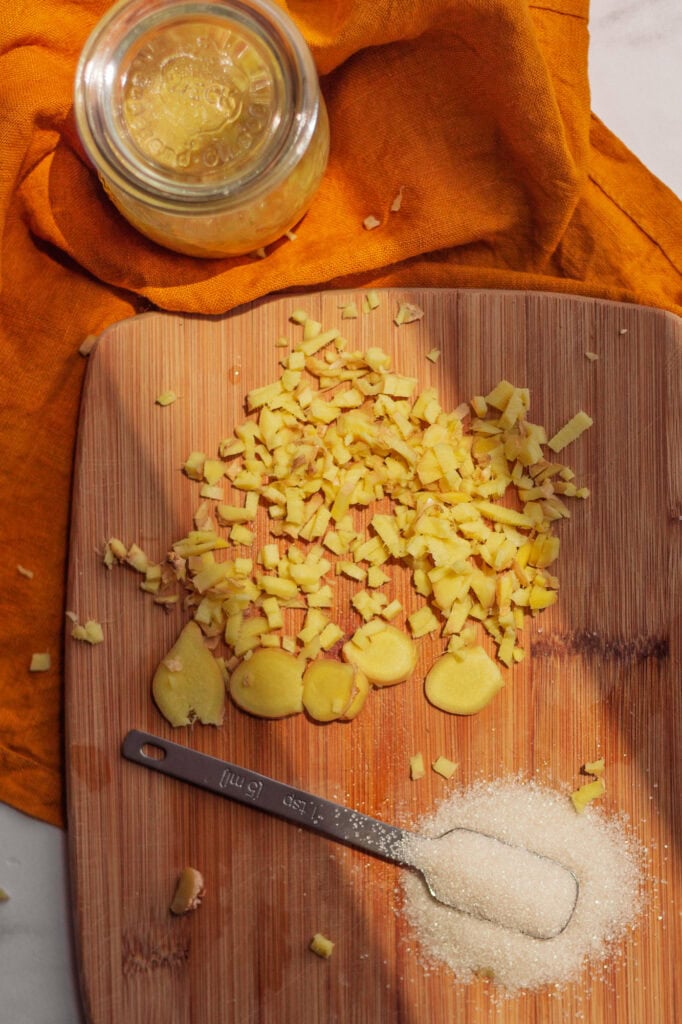
Deciding How Often to Brew
Once it’s all bubbly, we call it “established”, and we have a choice to make, which depends on how often we plan to brew natural soda.
- Option one: Use it all to brew. Start over from step one and make a fresh bug next time you plan to brew soda.
- Option two: Use some to brew and store the rest in a closed jar in the fridge as a “base starter.”
I prefer other fermented drinks and don’t make ginger bug sodas that often. If you are like me and only brew wild soda occasionally, for instance, I usually make wild ginger bug soda once or twice a year, you’ll want to go with option one in the recipe.
Now, if option one does not resonate with you, because you’re planning to brew wild soda with your ginger bug regularly, like every week, all the time, because you love ginger bug wild sodas, then you’ll make your ginger bug, and once it is established, stick it in the fridge.
While it is in the fridge, consider it a base ginger bug starter. To brew wild soda with it, you pull some of that base starter from the fridge, feed it fresh ginger, water, and sugar to make more of the bubbly bug to brew with. If you are familiar with sourdough, it’s similar to taking some sourdough discard from the fridge and using it to make an active starter at room temperature to bake with.
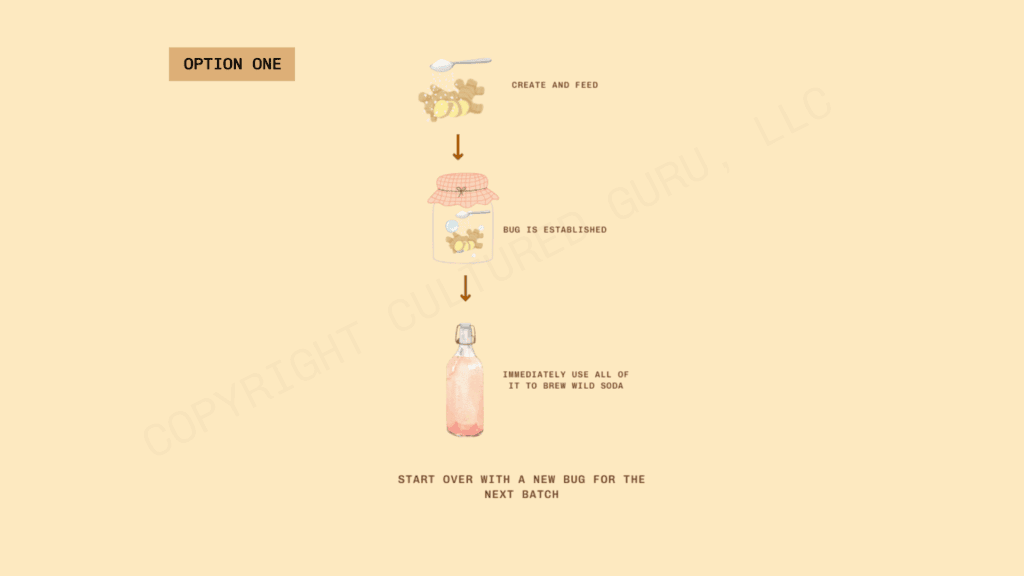

How to Store a Ginger Bug in the Fridge
So, if you plan to brew frequently, your base ginger bug should be stored in the refrigerator.
- You occasionally feed it to keep it active, but it remains in the fridge.
- To keep it moderately active, feed it once a week.
- Feed it by pouring off the liquid, then add a 20% sugar solution, and occasionally add fresh ginger.
- Feed, then immediately put it back in the fridge, so it metabolizes sugars more slowly.
- Keep a regular, solid lid on the jar (not a cloth lid).
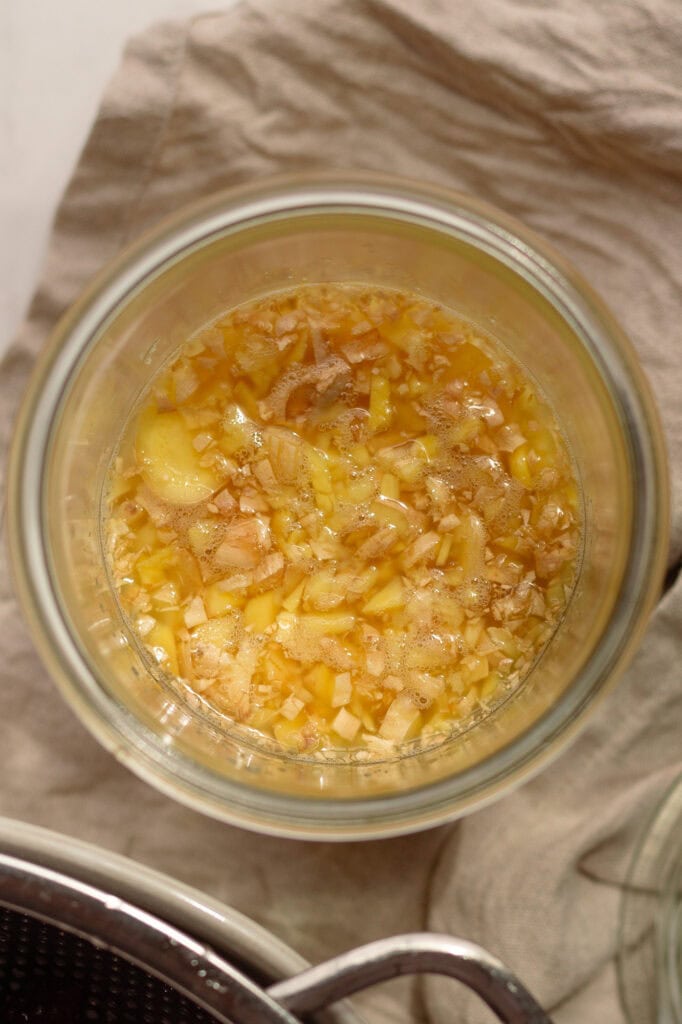
How to Activate from the Fridge for Brewing
To use your established ginger bug in the fridge for brewing, determine how much soda you’d like to brew. I suggest using 50 grams of ginger bug per one liter of soda.
In a clean jar, combine these ingredients in the following ratios: 10% bug from the fridge, 20% fresh, chopped ginger, 50% water, and 20% sugar.
So, if I want to brew, say, two liters of wild soda, I need about 100 grams bug in total. So I’ll combine:
- 10 grams of bug from the fridge
- 20 grams fresh chopped ginger
- 50 grams of water
- 20 grams of sugar
It should bubble soon after feeding, and you use it right away to brew ginger bug soda.
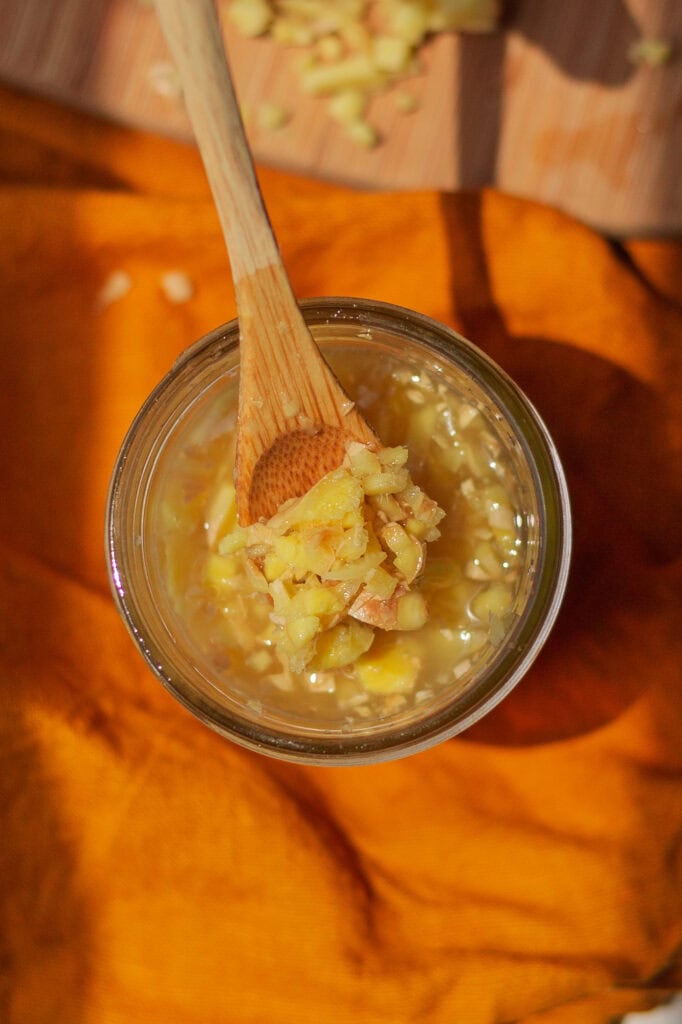
Can I Feed My Ginger Bug Turmeric?
Yes! You can feed it with ginger or turmeric. Switching back and forth and feeding it a mix of ginger and turmeric is also a great option!
You can also incorporate edible flowers into your ginger or turmeric bug. Additionally, it’s enjoyable to experiment with other rhizomes and roots, such as lotus root, carrot, sweet potato, and beets.
How Much Ginger Bug Do I Need?
The amount of ginger bug you need is determined by the amount of soda you intend to brew. You need 50 grams of ginger bug per one liter (1,000 mL) of wild soda. For example, if I want to brew 2 liters (2,000 mL) of soda, I’d need approximately 100 grams of ginger bug in total.
Can I use store bought ginger?
I don’t recommend it unless you can verify it is organically farmed and from healthy soil. Ask a grocery employee if they can tell you where the ginger is from.
With ginger bugs, we are growing wild microbes in sugar. Which is extremely different from and does not have the same safe guards as wild fermentation with salt (like sauerkraut and pickles). To be blunt, if you cannot source quality ginger from quality, healthy soil then don’t make a ginger bug. Try kombucha or water kefir instead.
Conventional ginger is often grown as a monocrop in poor soil. If your ginger comes from dead soil, and a grocery bin, then your bug will have the same microbiome as dead soil and a grocery bin.

How to Establish, Maintain and Use a Ginger Bug Wild Culture
You need a ginger bug to brew naturally fermented soda. Use this complete guide and recipe to learn how to establish, maintain, and use a ginger bug wild culture!
- Prep: 15 minutes
- Total Time: 48 hours 15 minutes
Ingredients
- fresh ginger root, organic, minced
- water
- organic sugar
- sea salt
Instructions
- Read the recipe notes before you begin. For this recipe to succeed, you must use high-quality, organic ginger from healthy soil. The bacteria and yeast cultures needed for fermentation live on the ginger. If you cannot source high quality ginger, please consider kombucha or water kefir instead.
- Ingredient amounts are not listed because you will all use different amounts depending on how long it takes for your bug to bubble and how much you plan to brew ginger bug sodas.
- Wash about 25 grams of ginger root and finely chop. (I suggest chopping/mincing with a knife, not grating)
- Combine 25 grams ginger root, 50 grams water, 5 grams organic sugar, and 2 grams sea salt. Stir until the sugar is fully dissolved.
- Cover with a tight-weave cloth secured with a rubber band and allow to ferment for 24 hours.
- Feeding: after 24 hours, feed the bug by adding 25 grams chopped ginger root, 50 grams water, and 5 grams organic sugar to the jar. (do not add more salt when feeding)
- Cover with a tight-weave cloth secured with a rubber band and allow to ferment for another 24 hours.
- Repeat feeding every 24 hours until it is bubbly. (should only take about 2 days)
- Once it’s very bubbly, we call it “established,” and we have two options
- Option one: Use it all to brew. Then, start over from step one and make a fresh bug next time you plan to brew ginger bug soda.
- Option two: Use some to brew and store the rest in a closed jar in the fridge as a “base starter.”
- If you plan to keep it alive in the fridge, feed once a week: Pour off the liquid, then add a 20% sugar solution, and occasionally add some fresh ginger. ( a 20% sugar solution for example is 10 grams of sugar in 50 mL of water)
- To revive a ginger bug from the fridge for brewing you need about 50 grams of bug per one liter of ginger bug soda. To make 100 grams of bug for brewing: combine 10 grams of bug from the fridge, 20 grams of fresh chopped ginger, 50 grams of water, and 20 grams of sugar in a clean jar. Cover with a cloth lid and allow to ferment at room temperature. It should be bubbly in a few hours. Once bubbly use it to brew ginger bug soda. Click here for my ginger bug soda master recipe.
Notes
- Your source of ginger matters. Homegrown and farmers’ market-sourced will yield the most lively, balanced bugs.
- Conventional store bought ginger is not recommended. Most non-organic ginger is treated with chemicals to stop it from sprouting. Conventional ginger crops are also sprayed with a variety of herbicides, fungicides, and insecticides. Non-organic fresh ginger root imported into the US is irradiated to kill microorganisms and extend its shelf life. For these reasons, most conventional ginger will not provide the healthy microbes necessary for successful fermentation.
- If you don’t have access to quality, organic ginger from healthy soil, try other roots. It’s enjoyable to experiment with other rhizomes and roots, such as lotus root, carrot, sweet potato, and beets. Just make sure they are organic and from healthy soil.
- Organic cane sugar is essential; conventional cane sugar contains too many pesticides to work well.
- If you only plan to brew a couple of times a year, don’t keep a bug in the fridge. It’s wasteful. Start a new bug the next time you plan to brew.
- You can use ginger or turmeric.















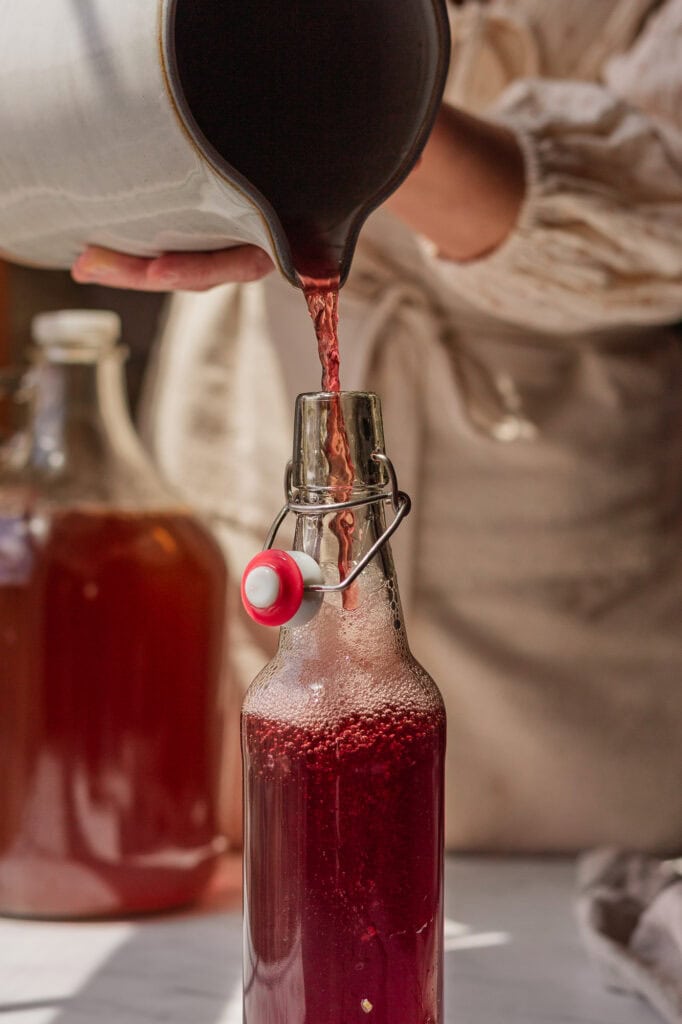
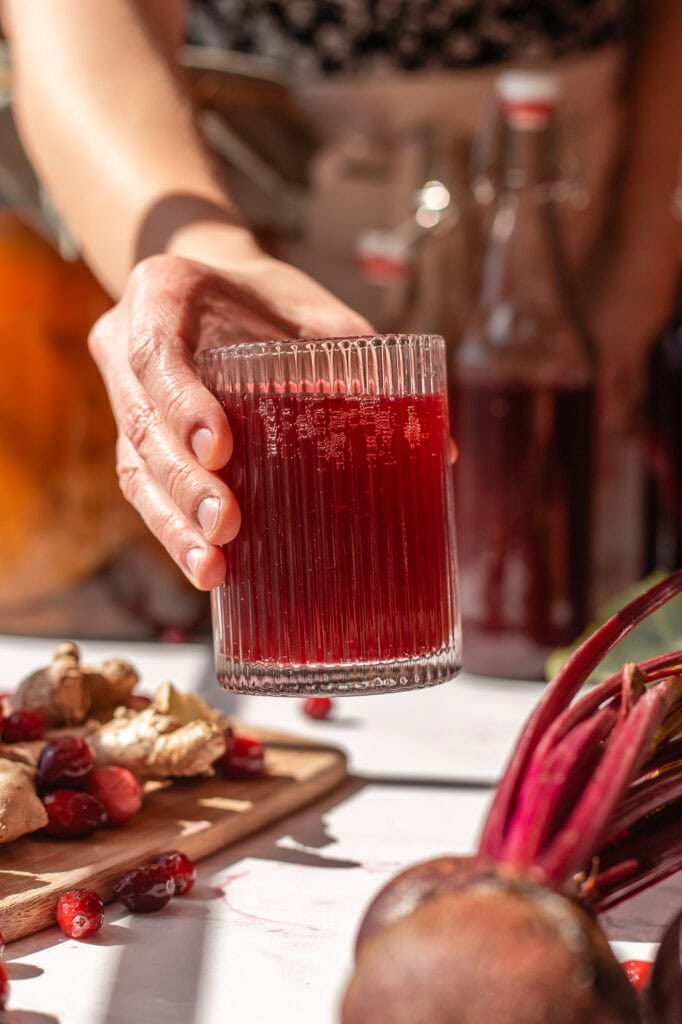
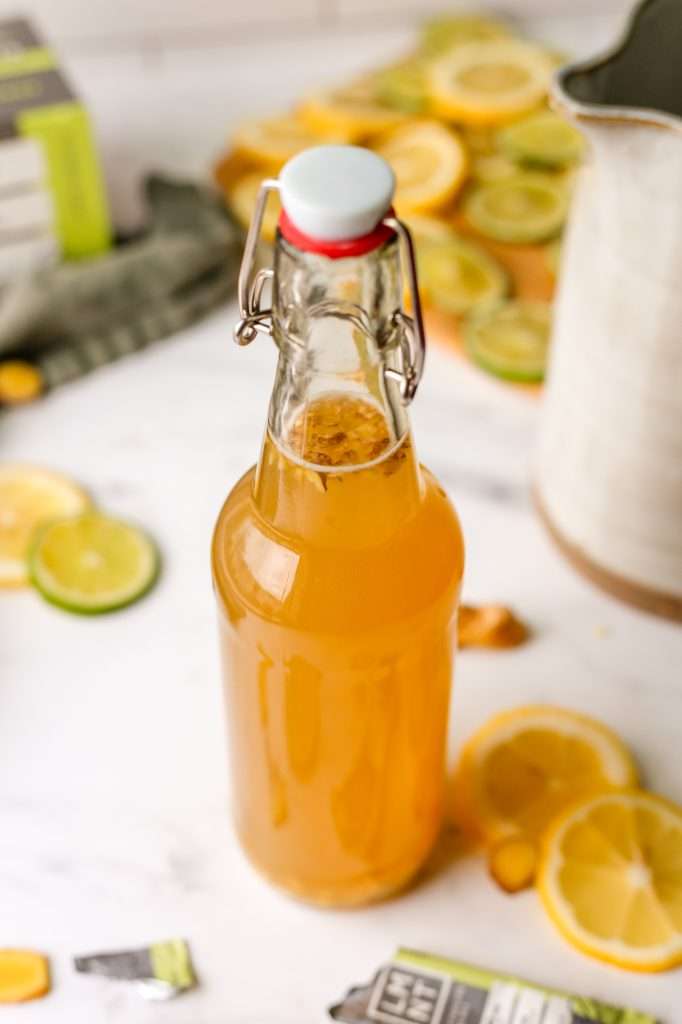

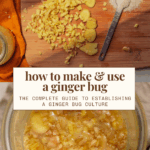
Hello! I am excited for you ginger bug/soda recipes. If you use tumeric instead, do you just start with tumeric or switch to it for feeding after the ginger bug is active? Assuming you add the salt for both versions? Thank you! I love every single recipe you create! I just made 3 more tonight 🤣 #addicted
You can just start with turmeric instead of ginger and follow the same exact recipe as written.
Hi…should the ginger be peeled? Or unpeeled?
washed and unpeeled!
Thank you for sharing everything with us. God bless you.
you’re welcome!